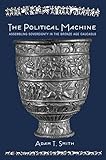The Political Machine : Assembling Sovereignty in the Bronze Age Caucasus / Adam T. Smith.
Material type: TextSeries: The Rostovtzeff Lectures ; 3Publisher: Princeton, NJ : Princeton University Press, [2015]Copyright date: ©2015Edition: Pilot project. eBook available to selected US libraries onlyDescription: 1 online resource : 25 halftones. 18 line illus. 1 table. 9 mapsContent type:
TextSeries: The Rostovtzeff Lectures ; 3Publisher: Princeton, NJ : Princeton University Press, [2015]Copyright date: ©2015Edition: Pilot project. eBook available to selected US libraries onlyDescription: 1 online resource : 25 halftones. 18 line illus. 1 table. 9 mapsContent type: - 9780691163239
- 9781400866502
- 939.5 23
- DS181 .S65 2017
- online - DeGruyter
- Issued also in print.
| Item type | Current library | Call number | URL | Status | Notes | Barcode | |
|---|---|---|---|---|---|---|---|
 eBook
eBook
|
Biblioteca "Angelicum" Pont. Univ. S.Tommaso d'Aquino Nuvola online | online - DeGruyter (Browse shelf(Opens below)) | Online access | Not for loan (Accesso limitato) | Accesso per gli utenti autorizzati / Access for authorized users | (dgr)9781400866502 |
Browsing Biblioteca "Angelicum" Pont. Univ. S.Tommaso d'Aquino shelves, Shelving location: Nuvola online Close shelf browser (Hides shelf browser)

|

|

|

|

|

|

|
||
| online - DeGruyter War and Democratic Constraint : How the Public Influences Foreign Policy / | online - DeGruyter White Backlash : Immigration, Race, and American Politics / | online - DeGruyter The Battle for Yellowstone : Morality and the Sacred Roots of Environmental Conflict / | online - DeGruyter The Political Machine : Assembling Sovereignty in the Bronze Age Caucasus / | online - DeGruyter Leonhard Euler : Mathematical Genius in the Enlightenment / | online - DeGruyter Being Modern in the Middle East : Revolution, Nationalism, Colonialism, and the Arab Middle Class / | online - DeGruyter Puccini's Turandot : The End of the Great Tradition / |
Frontmatter -- Contents -- Preface -- Introduction. Reverse Engineering the Polity -- PART I. The Machinery of Sovereignty -- CHAPTER 1. On Assemblages and Machines -- CHAPTER 2. On the Matter of Sovereignty -- PART II. Assembling Sovereignty -- CHAPTER 3. The Civilization Machine in the Early Bronze Age -- CHAPTER 4. The War Machine in the Middle Bronze Age -- CHAPTER 5. The Political Machine in the Late Bronze Age -- Conclusion -- References Cited -- Index
The Political Machine investigates the essential role that material culture plays in the practices and maintenance of political sovereignty. Through an archaeological exploration of the Bronze Age Caucasus, Adam Smith demonstrates that beyond assemblies of people, polities are just as importantly assemblages of things-from ballots and bullets to crowns, regalia, and licenses. Smith looks at the ways that these assemblages help to forge cohesive publics, separate sovereigns from a wider social mass, and formalize governance-and he considers how these developments continue to shape politics today.Smith shows that the formation of polities is as much about the process of manufacturing assemblages as it is about disciplining subjects, and that these material objects or "machines" sustain communities, orders, and institutions. The sensibilities, senses, and sentiments connecting people to things enabled political authority during the Bronze Age and fortify political power even in the contemporary world. Smith provides a detailed account of the transformation of communities in the Caucasus, from small-scale early Bronze Age villages committed to egalitarianism, to Late Bronze Age polities predicated on radical inequality, organized violence, and a centralized apparatus of rule.From Bronze Age traditions of mortuary ritual and divination to current controversies over flag pins and Predator drones, The Political Machine sheds new light on how material goods authorize and defend political order.
Issued also in print.
Mode of access: Internet via World Wide Web.
In English.
Description based on online resource; title from PDF title page (publisher's Web site, viewed 23. Mai 2019)


